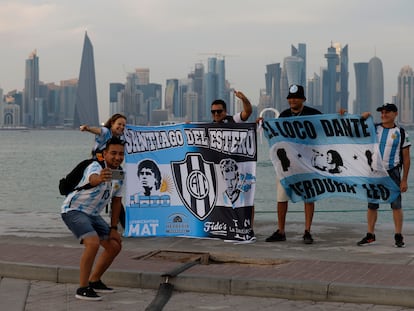Why Napoli is close to winning a Serie A title, 33 years after Maradona’s squad managed the feat
After a three-decade drought since the Argentine soccer star’s glory days in Naples, the still-superstitious city is finally poised to capture another ‘scudetto’
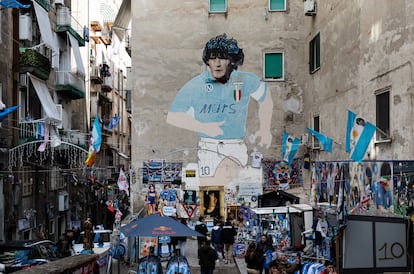
On the morning of March 11, 1987, the entrance of the largest cemetery in Naples, Poggioreale, was festooned with a blue banner that read “You don’t know what you’ve missed” in white letters. The message alluded to the team’s historic victory against Brescia the day before. The venerable denizens of the cemetery had not been able to enjoy Napoli’s first scudetto, or Serie A title, in its history. Napoli had hardly any trophies to its name but an intense and loyal fanbase. But, above all, those in Poggioreale were unable to witness the Argentine football genius Diego Maradona restore pride to all of southern Italy, which had been crushed by inequality and the arrogance of northern Italy, clearly represented by Michel Platini’s Juventus squad. Three seasons later the team from Naples won the title once again. But 33 years have passed since then, and memories are beginning to fade.
Now, the team seems poised to end its title drought soon. But nobody wants to talk openly about it. Nobody wants to jinx it. Only smiles, knowing glances and discussions of specific match details are allowed. That, and donations. On many streets of downtown Naples, in the Forcella and Quartieri Spagnoli neighborhoods, residents have placed stalls with scarves and Napoli paraphernalia that hide a piggy bank. Everyone gives what they can: €5, €10, €20. “Mount Vesuvius is going to explode, my friend. You can’t imagine what it’s going to be like,” says Andrea, as he sits in a plastic chair outside a coffee shop in Forcella.
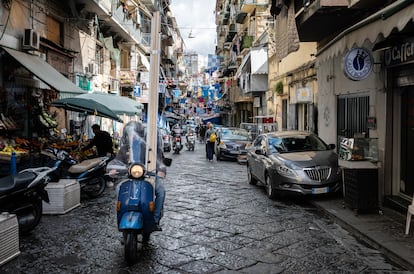
It is an enormous feat. With 12 games remaining, Luciano Spalletti’s team is 18 points ahead of second-place Inter Milan. On Saturday, the Azzurri won again against Atalanta (2-0), paving the way for what looks to be a triumphant march to the league title. In 2004, Napoli was a broken team; now, it scares the teams in the Champions League (this week it is defending a 0-2 against Eintracht Frankfurt to advance to the quarterfinals) and is one step away from its third scudetto.
The last one came 33 years ago, when Diego Armando Maradona was still playing for the team and walking the alleys of Forcella, sometimes hand in hand with the Giuliano clan. “Look, this is me with Diego. It was the day of my christening,” says Andrea, showing a photo on his cell phone; in the picture, he is two years old and Maradona is holding him. “This was like his second home. He was always running around here. But now the Quartieri want to claim him. If we win the scudetto, they’ll hear about it,” he announces, highlighting the historic rivalry between the neighborhoods over who is the most Neapolitan.
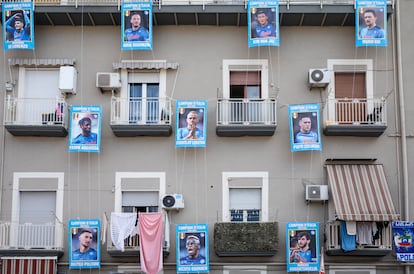
The alleyways are already decorated. Huge pictures of the team’s players hang from a building façade as if they were laundry drying on a clothesline. Life-size figures of the players have been placed two steps away from the plaza in Quartieri Spagnoli where there’s a mural of Diego Maradona. The Napoli team song blares loudly as tourists buy Osimhen-style masks (Victor Osimhen is the team’s striker and star; he has worn a mask on the pitch since he fractured his face in an in-game collision a year ago). The Nigerian star also inspired the town’s best-selling cake.
Naples is all euphoria these days. On Via San Gregorio Armeno, the alley famed for selling Christmas Nativity scenes, the stores now sell only figurines of players. There is even a figurine of club president, Aurelio De Laurentiis (ADL). At the beginning of the season, everyone criticized him for selling stars like Dries Mertens and Kalidou Koulibaly, but now the entire city reveres him for having built a devastating team with unknown players like Osimhen, Korean defender Kim Min-Jae and Georgian Khvicha Kvaratskhelia, with whom everyone in the stadium has fallen in love. It’s been a tough road to get here. And much of the success is because of De Laurentiis.

In the summer of 2004, ADL, a short guy with a devilish temper, was having breakfast on his terrace in Capri when he read in Il mattino that Napoli was broke and about to be auctioned off. The historic club, which had won two scudetti and a UEFA with Maradona just over a decade earlier, was now reduced to an old concrete stadium in the city’s Fuorigrotta neighborhood, a melancholy fanbase and a handful of IOUs. De Laurentiis didn’t know anything about soccer; he was interested in basketball. But he bought the team and invested €120 million in it. In three years, he got the team up to Serie A. He wanted to implement a contract model like the ones he had his actors sign and to keep finances in check. If soccer was the biggest TV show in Italy, why shouldn’t he apply the same methods that had brought him such handsome profits in the film industry? The problem was that he also had to contend with the enormous legend of Maradona on the pitch (today, Napoli’s stadium is named after the Argentine great).
A scudetto would break down the psychological barrier that has turned a memory into heavy baggage. Naples has always been determined to compete against itself, to destroy itself in the shadow of the volcano that’s always threatened its existence. Even now, on the verge of a historic victory, many dispute the origins of success and Maradona’s sympathy. On the heels of Argentina’s recent World Cup victory without his help, Maradona will be able to see how the other team in his life celebrates its win, wherever he is. As will the residents of Poggioreale cemetery.
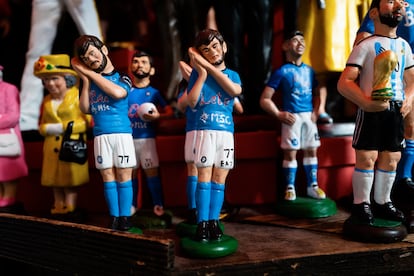
Sign up for our weekly newsletter to get more English-language news coverage from EL PAÍS USA Edition
Tu suscripción se está usando en otro dispositivo
¿Quieres añadir otro usuario a tu suscripción?
Si continúas leyendo en este dispositivo, no se podrá leer en el otro.
FlechaTu suscripción se está usando en otro dispositivo y solo puedes acceder a EL PAÍS desde un dispositivo a la vez.
Si quieres compartir tu cuenta, cambia tu suscripción a la modalidad Premium, así podrás añadir otro usuario. Cada uno accederá con su propia cuenta de email, lo que os permitirá personalizar vuestra experiencia en EL PAÍS.
¿Tienes una suscripción de empresa? Accede aquí para contratar más cuentas.
En el caso de no saber quién está usando tu cuenta, te recomendamos cambiar tu contraseña aquí.
Si decides continuar compartiendo tu cuenta, este mensaje se mostrará en tu dispositivo y en el de la otra persona que está usando tu cuenta de forma indefinida, afectando a tu experiencia de lectura. Puedes consultar aquí los términos y condiciones de la suscripción digital.
More information
Archived In
Últimas noticias
Most viewed
- Oona Chaplin: ‘I told James Cameron that I was living in a treehouse and starting a permaculture project with a friend’
- Reinhard Genzel, Nobel laureate in physics: ‘One-minute videos will never give you the truth’
- Sinaloa Cartel war is taking its toll on Los Chapitos
- Why the price of coffee has skyrocketed: from Brazilian plantations to specialty coffee houses
- Silver prices are going crazy: This is what’s fueling the rally

